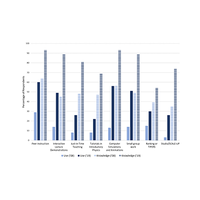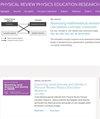在过去十年中,物理教师对主动学习的了解和使用有所增加,但大多数教师仍过多地进行讲授
IF 2.6
2区 教育学
Q1 EDUCATION & EDUCATIONAL RESEARCH
Physical Review Physics Education Research
Pub Date : 2024-04-02
DOI:10.1103/physrevphyseducres.20.010119
引用次数: 0
摘要
2008 年对 722 名物理教师进行的一项调查发现,许多物理教师对基于研究的教学策略(RBIS)有所了解,并有兴趣使用更多的策略,但往往在尝试之后就不再使用。在 2008 年之后的十年间,我们付出了巨大的努力,开发和传播物理学中的研究性教学策略,并改变物理学界的文化,重视研究性教学策略的使用和其他形式的以学生为中心的教学。本文利用2019年对1176名物理教师的调查数据,了解了RBIS在大学入门级物理教学中的使用现状,从而使我们能够更好地理解这些努力对物理教学的一些影响。结果显示,自我报告的对 RBIS 的了解和使用大幅增加,目前中断使用的情况相对较少。然而,尽管讲课时间所占比例比 10 年前有所减少,但许多教师仍在进行大量讲课(即超过课堂时间的三分之一)。与此相关的是,我们发现大多数 RBIS 的使用集中于旨在补充以讲授为主的课堂的教学法,而不是旨在支持以主动学习为主的课堂的教学法。这表明,物理教育研究团体及其他团体已经很好地推广了有关 RBIS 的知识,并激励教师在其课程中尝试使用 RBIS。但是,仍有改进的余地。根据现有的有效教学实践证据,我们建议变革推动者重点支持教师提高课堂主动学习时间的比例,并实施影响更大的策略。本文章由计算机程序翻译,如有差异,请以英文原文为准。

Physics instructors’ knowledge and use of active learning has increased over the last decade but most still lecture too much
A survey of 722 physics faculty conducted in 2008 found that many physics instructors had knowledge of research-based instructional strategies (RBISs), were interested in using more, but often discontinued use after trying. Considerable effort has been made during the decade following 2008 to develop and disseminate RBISs in physics as well as change the culture within the physics community to value RBIS use and other forms of student-centered instruction. This paper uses data from a 2019 survey of 1176 physics instructors to understand the current state of RBIS use in college-level introductory physics, thus allowing us to better understand some of the impacts of these efforts on physics instruction. Results show that self-reported knowledge and use of RBISs has increased considerably and discontinuation is now relatively low. However, although the percentage of time lecturing is less than 10 years ago, many instructors still engage in substantial lecturing (i.e., more than one-third of class time). Relatedly, we find that the majority of RBIS use centers on pedagogies designed to supplement a primarily lecture-based classroom rather than pedagogies designed to support a primarily active learning classroom. This suggests that the physics education research community and beyond has done well promoting knowledge about RBISs and inspiring instructors to try RBISs in their courses. But, there is still room to improve. Based on available evidence about effective instructional practices, we recommend that change agents focus on supporting instructors to increase the percent of class time in active learning and to implement higher impact strategies.
求助全文
通过发布文献求助,成功后即可免费获取论文全文。
去求助
来源期刊

Physical Review Physics Education Research
Social Sciences-Education
CiteScore
5.70
自引率
41.90%
发文量
84
审稿时长
32 weeks
期刊介绍:
PRPER covers all educational levels, from elementary through graduate education. All topics in experimental and theoretical physics education research are accepted, including, but not limited to:
Educational policy
Instructional strategies, and materials development
Research methodology
Epistemology, attitudes, and beliefs
Learning environment
Scientific reasoning and problem solving
Diversity and inclusion
Learning theory
Student participation
Faculty and teacher professional development
 求助内容:
求助内容: 应助结果提醒方式:
应助结果提醒方式:


